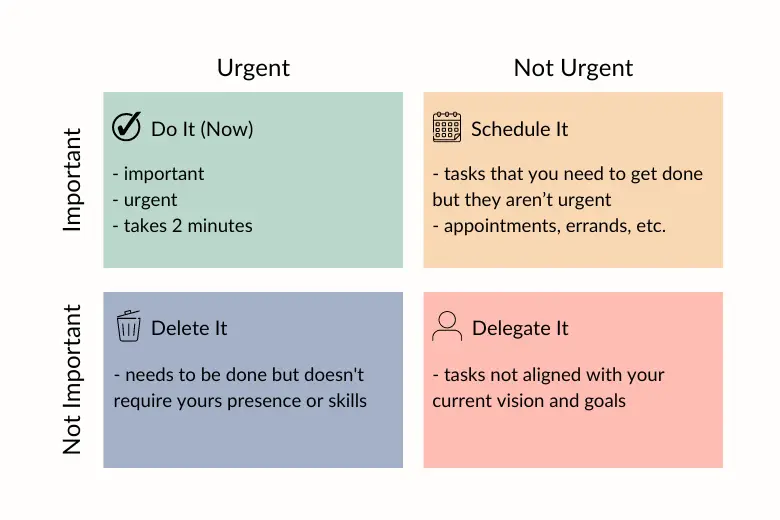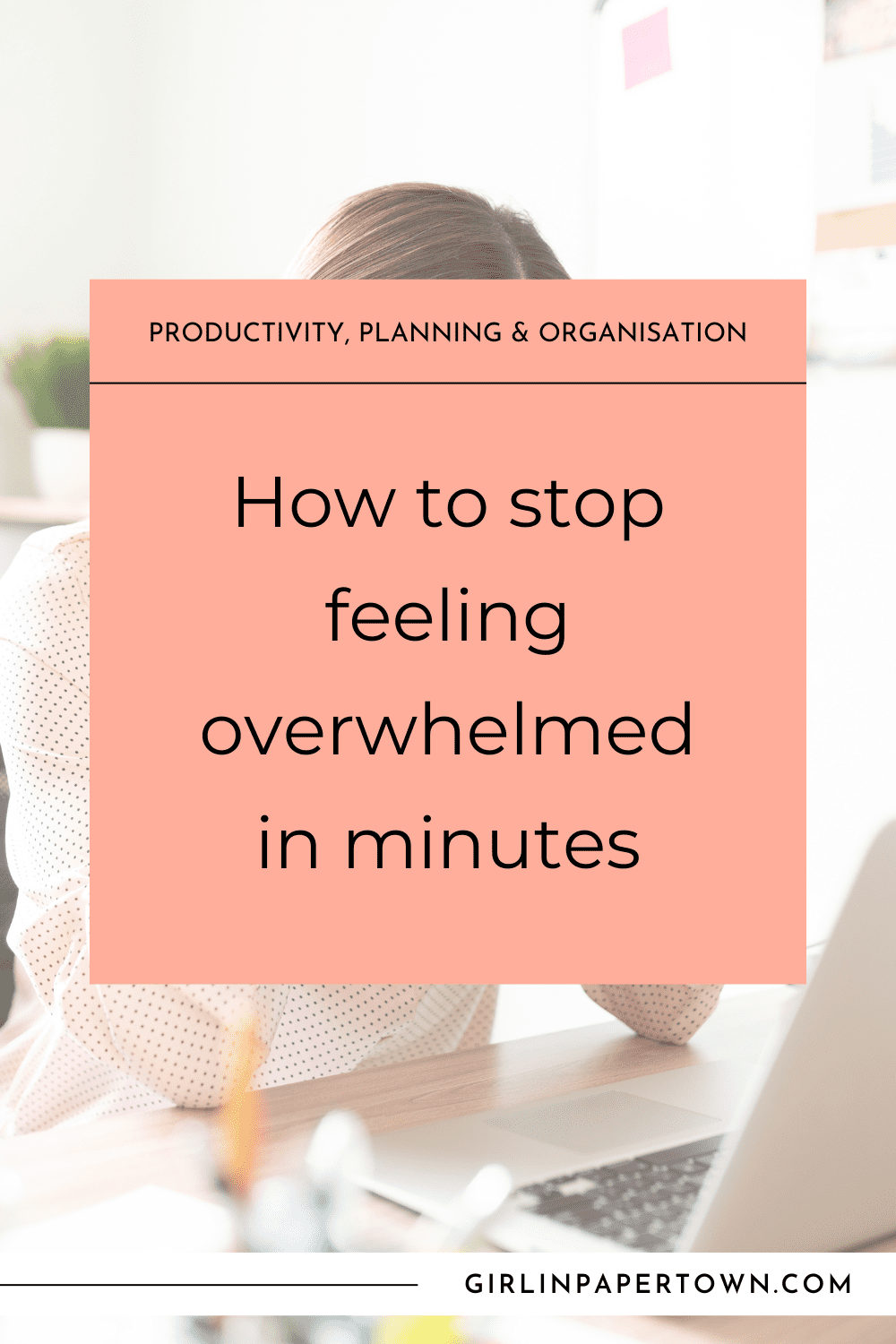Feeling overwhelmed? Close those damn open loops!
Some of the links in this post are affiliate links which means I earn a small commission if you purchase or book through my link, at no extra cost to you.
Does this sound familiar: you feel overwhelmed, drained from energy, and have so much to do that you don’t know where to start? We’ve all been there at least once. So what’s the deal?
You might have too many open loops!
Navigate to where you want to go:
What are open loops?
You might ask. Open loops are those tasks that you’ve started but haven’t finished yet. It can be anything from doing the laundry, getting an interesting blog post idea, to a major assignment at work.
Open loops stay on your mind until you close them. One or two of them won’t make a vast difference, but once they’ll start piling up, you’re bound to get stressed. When your mind is racing all the time trying to remember all things you need to do, it’s difficult to focus on your tasks or fall asleep at night. If you’re anything like me, you might feel like this quite often. But how can you deal with that, close those damn open loops and clear your mind to be more relaxed and productive? Let’s dive in.
Why open loops cause stress?
Every time a new idea pops into your mind and you don’t deal with it, it creates a new open loop. Same thing happens when you start a task but don’t finish it, have a project to do but don’t act on it, etc. There are two things that bring the most stress: fact that tasks are unfinished and the unknown. Everyone enjoys completing things, tick the boxes, and all that stuff. Zeigarnik effect states that people remember unfinished or interrupted tasks better than completed tasks.
Having too many open loops leads to overwhelm and stress as you can’t concentrate on the tasks you’re doing right now knowing that there are others waiting for you. They’re taking a lot of your mental energy, leaving none of it for really important tasks. What’s more, open loops constantly pressurise you, making it impossible to rest and recharge. This leads to lower mental energy the next day, making it impossible to be productive.
Open loops keep building up, making your to-do list longer and longer. Everything seems to be urgent, so you hope to complete them in one or two days. When you see a huge list of tasks to do, you’re getting more anxious and you’re more likely to procrastinate and have lower self-esteem.
There’s also another thing that causes stress: the unknown. When you have a project to do, you don’t know the exact steps you need to take in order to do it. Without a plan, you don’t know how to proceed, what’s the outcome will look out, or how much time it will take. All those things can make you anxious and it’ll be tempting to postpone it as long as possible. That’s why it’s worth to close open loops by planning them out first and acting on them immediately.
Why should you close open loops?
By closing open loops, you clear your mind and save space to remember truly important things. Did you know that the human brain’s memory could store the entire Internet? Every open loop steals a bit of that memory space, making it harder and harder to keep important information, focus, and function properly. Closing open loops also improves your productivity and minimise risk of procrastination. You won’t be distracted by tasks and thoughts circulating around your mind once you finish them. It also reduces your to-do list and stress related to it and gives you some sense of progression and completion. It feels good to check things off your to-do list, isn’t it?
Three steps to lessen overwhelm and tackle existing open loops
Step 1: Do a brain dump
I love a solid brain dump, so it shouldn’t come as a surprise that this is the first step I’d take here. When you have a lot of thoughts running through your mind, you need to write them all down. Think of all your commitments and appointments. Do you need to book a doctor’s appointment? Did you promise to bake a cake for your aunt’s birthday party? Write it down. Look around your house. Did you want to declutter your chest of drawers, organise kitchen cabinets, or need to pay the bills? Add it to the list. Take your time and list all the things that are on your mind, no matter how small or big they are.
Step 2: Create a running master list
Once you finished your brain dump session, it’s time to create a running master to-do list. It will serve as a hub for all your tasks that need to be done. Create a system that works, whether it’s in the mobile app or in your paper planner. There’s no good or wrong way of doing that. My favourite way to keep a running master list is in Notion. This way I have just one long list with all tasks categorised and tagged properly. If you want to stick to pen and paper, you might want to create a few lists for different categories, e.g. one for personal tasks, another for work / business, home, kids, etc.
You can now add all your to-dos from your brain dump session to the master list. It will come handy in the next step. It’s important to update your list regularly.
Step 3: Use Eisenhower Matrix

You might’ve heard about Eisenhower Matrix – a visual tool used to prioritise tasks. It ranks them by importance and urgency and divides them into four categories: do, schedule, delegate, and delete. I like to use it in slightly different version, where I don’t prioritise tasks by importance and urgency but still categorise them into those four categories mentioned earlier.
Do It
Go through the list created during your brainstorm session and see if they’re any tasks that can or need to be done right now. Look for anything that’s important, urgent, or just takes less than 2 minutes and focus on them. If you’re unable to tackle them all in one go, create reminders or schedule them.
Schedule It
Now that the list is shorter, go through it once again and see what do you need to put on your schedule. Are there any tasks that you need to get done but aren’t urgent?
Sometimes we can’t do the task right now. If you need to run errands or call the doctor, put it on your calendar and set a reminder. Set aside some time during the day to tackle those tasks once and for all.
Delegate It
I know how difficult it can be to delegate some tasks to someone else. We want to be always in control and believe that we’ll do it better than someone else. When you have a lot on your plate, you need to focus on what’s really important, though, and that’s where delegating tasks comes into play. It’s an important ability to learn and will help you close all your open loops faster.
Go through your list once again. Check what tasks you can delegate to someone else. For example, you can ask your partner to return a parcel or call the estate agency. You don’t have to do everything alone; you know?
Delete It
You should have only a handful of tasks right now. It might be tricky to deal with them, as it’s difficult to just get rid of them. They stayed on your mind for a while and might seem like they’re all important. Tread carefully and decide which tasks you can safely drop from your list. Ask yourself if the task is aligned with your current vision and goals. Is it something you only wanted to do because you’ve seen someone else doing it and thought it would be cool to do the same? If that’s the only reason, then delete it. Give yourself permission to focus on what’s really important. If the task doesn’t bring any value to your life, remove it from your list.
RELATED ARTICLE:
⪼ 25 Ideas To Create The Best Self-Care Weekend Ever
⪼ New month, new goals – how to set monthly goals and succeed
Open loops and productivity: 4 tips
Avoid opening new loops
Too many tasks
One of the most easy ways of creating new open loops is filling up your schedule to the brim. When you do that, there’s almost 100% chance that you won’t be able to accomplish everything you’ve planned and unfinished tasks become your next open loops.
Procrastination and open loops
Procrastination can play a big part in it, too. I spend so much time procrastinating that’s actually unreal. Because I’m being easily distracted by more “interesting” things, I usually end up with many tasks that I started during the day but never finished. It’s the easiest way to get overwhelmed, too.
Turn off notifications
One of the most common distractions is notifications, both on your phone and your computer. Try to postpone checking your emails and messages until you’ve tackled the most important tasks for the day. This way, new open loops won’t interfere with your existing ones too much.
Set boundaries
It’s important that you know your boundaries and don’t say “yes” to everything that comes your way. This way you’ll have more space in your calendar to deal with things that are really important to you, you’ll feel better about yourself, and you won’t risk opening new loops. Accepting a party invitation doesn’t seem like a big deal, but if you’re going just because you feel you have to, you’ll simply waste your time there. Also, you’ll need to shop for a birthday present, which adds another open loop to your list. Saying no to new commitments means you’re honouring your existing ones. Boundaries aren’t just about getting what you want, they help you live your life on your own terms.
Schedule an open loops day
Recently, I stopped scheduling any major tasks for Fridays and use this time to tackle open loops tasks that haven’t been closed during the week. This way I don’t have to stress too much when I don’t have enough time or energy to finish all my to dos on time.
If you have a lot of open loops on your list, you can schedule an entire week to tackle them. This way, you’ll be able to move on faster. It might be a good idea to schedule an open loops week every couple of months, for example once a quarter, every six months, or just before New Year’s Eve.
2 minute rule
David Allen, author of Getting Things Done, states that “If an action will take less than two minutes, it should be done at the moment it’s defined.”
I believe that one of the best ways to deal with open loops is by doing tasks immediately. When you see a dirty plate on a table, don’t leave it there. This will open another loop that will stay in the back of your mind. Instead, take it back to the sink. By doing the task immediately after it popped up in your mind, you’re making your life much easier. Stuff like that quickly piles up and it might become difficult to focus on important things. 2 minute rule really works and it also makes you feel more efficient.
Map out your bigger open loops, aka projects
Bigger open loops that represent projects are the most stressful of them all. It’s mostly because you don’t know the details and unknown overwhelms and makes you anxious. Map out your projects and remember about being as detailed as possible. Then, set goals and schedule everything out. Set a few checkpoints along the way to make sure that you’re staying on track. Your mind will calm down once it’ll exactly know what to do and when.
PIN FOR LATER!

Open loops: Conclusion
There is a better way than feeling overwhelmed and buried under the pile of tasks and thoughts running around your head all the time. Closing open loops can be easy, but sometimes it’s the last thing we want to do. There are many different, more interesting things you’d like to do right now, wouldn’t you? By mapping out your projects, brain dumping all your thoughts, and taking care of them, you’ll feel much better about yourself and your productivity will increase. Just don’t forget to destroy all your brain dump notes once you’re done. Otherwise, you might find them in a few weeks and become overwhelmed, not knowing what to do with it.




